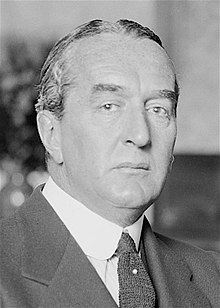The 1920s Portal
Silent films were popular in this decade, with the highest-grossing film of this decade being either the American silent epic adventure-drama film Ben-Hur: A Tale of the Christ or the American silent war drama film The Big Parade, depending on the metrics used. Sinclair Lewis was a popular author in the United States in the 1920s, with his books Main Street and Elmer Gantry becoming best-sellers. Best-selling books outside the US included the Czech book The Good Soldier Švejk, which sold 20 million copies. Songs of this decade included "Mack the Knife" and "Tiptoe Through the Tulips". During the 1920s, the world population increased from 1.87 to 2.05 billion, with approximately 700 million births and 525 million deaths in total. (Full article...) Selected article -The 1926 World Series was the championship series of the 1926 Major League Baseball season. The 23rd edition of the Series, it pitted the National League champion St. Louis Cardinals against the American League champion New York Yankees. The Cardinals defeated the Yankees four games to three in the best-of-seven series, which took place from October 2 to 10, 1926, at Yankee Stadium and Sportsman's Park. This was the first World Series appearance (and first National League pennant win) for the Cardinals, and would be the first of 11 World Series championships in Cardinals history. The Yankees were playing in their fourth World Series in six years after winning their first American League pennant in 1921 and their first world championship in 1923. They would play in another 36 World Series (and win 26 of those), as of the end of the 2023 season. (Full article...) Featured picture A portrait of Lillian Gish from 1921. Gish was one of the first female movie stars, called "The First Lady of American Cinema", starting in 1912 and continuing to appear in films until 1987. The American Film Institute named Gish 17th among the greatest female stars of all time and awarded her a Life Achievement Award, making her the only recipient who was a major figure in the silent era. Remarkably, she never won an Academy Award for her work, although she did receive a Special Academy Award in 1971. Did you know...
Related portalsSelected biography -Stanley Melbourne Bruce, 1st Viscount Bruce of Melbourne (15 April 1883 – 25 August 1967) was an Australian politician, statesman and businessman who served as the eighth prime minister of Australia from 1923 to 1929. He held office as the leader of the Nationalist Party, having previously served as the treasurer of Australia from 1921 to 1923. Born into a briefly wealthy Melbourne family, Bruce studied at the University of Cambridge and played a leading role in his family's softgoods firm following the suicide of his father John Munro Bruce. He served on the front lines of the Gallipoli Campaign in World War I and returned to Australia wounded in 1917, becoming a spokesman for government recruitment efforts. He gained the attention of the Nationalist Party and prime minister Billy Hughes, who encouraged a political career. He was elected to the House of Representatives in 1918, becoming member of parliament (MP) for the seat of Flinders. He was appointed as treasurer in 1921, before replacing Hughes as prime minister in 1923. He established an anti-socialist coalition government with the agrarian Country Party, working closely with Country leader Earle Page in an arrangement that pioneered the modern Liberal–National coalition. (Full article...) TopicsWikiProjects
List articlesMore Did you know (auto generated)
CategoriesGeneral imagesThe following are images from various 1920s-related articles on Wikipedia.
Recognized content
Associated WikimediaThe following Wikimedia Foundation sister projects provide more on this subject:
Discover Wikipedia using portals |























































